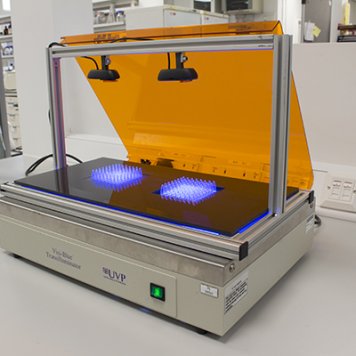Adjustable transilluminating blackbox for monitoring cell-free expressions
To monitor our cell-free biopixels, we built an adjustable transilluminating blackbox. To excite our green fluorescent proteins we used a discarded transilluminator. (Many thanks to the Haseloff Lab from University of Cambridge) but you can also build your own, if needed.

To mount our cameras and make them adjustable in its x/z/y axis, we used Valuframe to create a frame that fits on top of our transilluminator.Valuframe is practical as it has many additional parts that enable sliding and mounting accessories.

In our case we used 2 sliders to mount our webcameras. To make them easier adjustable we removed the hinge and mounted them with 3d printed connectors (here the file to download for the sliders).
To filter the UV light while monitoring we glued a UV filtering plastic sheet on top of the camera lense. Be careful to not get any glue on the lense itself! To learn more how to create a cheap timelapse to monitor the pixels follow our timelapse tutorial.

To only see our green fluorescent pixels and protect our eyes from the UV light, we created a black box to cover up the whole construction.For this we used leftover MDF and painted it black. You can use also thick cardboard - just make sure the material doesn’t let any light through.

You can use the box for many other fun applications and mount easily different cameras to it.

